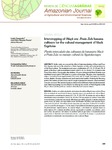Use este identificador para citar ou linkar para este item:
http://www.alice.cnptia.embrapa.br/alice/handle/doc/978145| Título: | Intercropping of Maçã and Prata Zulu banana cultivars for the cultural management of black Sigatoka. |
| Autoria: | GASPAROTTO, L.  PEREIRA, J. C. R.   MOREIRA, A.   |
| Afiliação: | LUADIR GASPAROTTO, CPAA; JOSE CLERIO REZENDE PEREIRA, CPAA; ADONIS MOREIRA, CNPSO. |
| Ano de publicação: | 2013 |
| Referência: | Revista de Ciências Agrárias, Belém, PA, v. 56, n. 4, p. 299-302, out./dez. 2013. |
| Conteúdo: | ABSTRACT: In this study, we assessed the effect of intercrop planting of Maçã and Prata Zulu banana cultivars in the reduction of black Sigatoka severity and in the productivity of the Maçã cultivar. The treatments used were a combination of 5, 10, 15, 20 and 25% of plants of the Maçã cultivar distributed in plots with 95, 90, 85, 80 and 75% of plants of the Prata Zulu cultivar. Four months after planting, 20 leaves infected with black Sigatoka were distributed at each plot of 200 plants as a source of inoculum. The plots were separated by strips of secondary forest approximately 20 m wide and 15 m high. Each plot was divided in four subplots. Severity evaluation was performed in leaf number 10 during the flowering period. The number of viable leaves and the weight of production (bunches, hands and fruits) were also assessed. The statistical analyses did not show differences between the treatments used. Intercrop planting was not effective in reducing the severity of black Sigatoka in the Maçã cultivar and the yield was similar to that observed in monocultures. RESUMO: Avaliou-se o efeito do plantio intercalado da cultivar Maçã com a cultivar Prata Zulu na redução da severidade da doença sigatoka-negra e na produção da cultivar Maçã. Os tratamentos consistiram do plantio de 5, 10, 15, 20 e 25% de plantas da cultivar Maçã, distribuídas dentro de talhões com 95, 90, 85, 80 e 75% de plantas da cultivar Prata Zulu, respectivamente, perfazendo um total de 200 plantas por talhão. Quando as plantas atingiram quatro meses de idade, em cada talhão foram distribuídas 20 folhas com sigatoka-negra, como fonte de inóculo. Os talhões foram separados por uma faixa de floresta secundária com cerca de 20 m de largura e 15 m de altura. Cada talhão foi dividido em quatro parcelas. No florescimento, registraram-se, na cultivar Maçã, a severidade da sigatoka-negra na folha número 10 e o número de folhas viáveis, registrando-se também, na colheita, o peso dos cachos, das pencas e dos frutos. As análises indicam que todos os tratamentos foram iguais entre si. O plantio intercalado não reduziu a severidade da doença e a produção foi semelhante às registradas em monoculturas com a cultivar Maçã. Intercropping of Maçã and Prata Zulu banana cultivars for the cultural management of black Sigatoka Plantio intercalado das cultivares de bananeira Maçã e Prata Zulu no manejo cultural da Sigatoka-negra. |
| Thesagro: | Doença de planta Banana |
| NAL Thesaurus: | Plant diseases and disorders |
| Digital Object Identifier: | 10.4322/rca.2013.045 |
| Tipo do material: | Artigo de periódico |
| Acesso: | openAccess |
| Aparece nas coleções: | Artigo em periódico indexado (CNPSO)  |
Arquivos associados a este item:
| Arquivo | Descrição | Tamanho | Formato | |
|---|---|---|---|---|
| adonis.2013.intercropping.pdf | 405,83 kB | Adobe PDF |  Visualizar/Abrir |









